Browse using the new Vinous website now. Launch →
Printed by, and for the sole use of . All rights reserved © 2015 Vinous Media
From Revolution to Evolution: The Garnatxas and Cariñenas of Priorat & Montsant
BY JOAQUÍN HIDALGO | NOVEMBER 7, 2024
René Barbier Jr. is driving us along a winding road toward the town of La Figuera in Montsant. He wants to take me somewhere where I can see the whole of Priorat from above. Barbier is an affable fellow who tends to pay more attention to what he has to say than he does to the road, but he knows this road well—he’s been coming up here for as long as he can remember. Lined on both sides by pine forest, the road is only wide enough for one car at a time. Limestone cliffs loom over us, and the higher we climb, the more I lose my grasp on space. The landscape is familiar to me, too. As someone raised in the mountains, the sense that the horizon is lurking around every bend is always thrilling. I think about that as we proceed, savoring the adrenaline of altitude and the eagerness to discover what awaits on the other side. What I see when we reach the peak takes my breath away: a sea where the waves are mountain ridges and formations eroded into different shapes, held back on one side by a white wall—the Sierra of Montsant—while higher peaks form the other borders. This spring, that sea is green, its soft surface scattered with vineyards, terraces and the rooftops of the nine towns of Priorat.
Barbier and I discuss the history of the region. His father, René Barbier Sr. (Clos Mogador), together with Álvaro Palacios (L’Ermita), Josep Lluis Pérez (Mas Martinet), Daphne Glorian (Clos i Terrasses) and Carlos Pastrana (Clos de l’Obac), was one of the winemakers who put Priorat back on the map in the 1990s after a lengthy period of neglect. Until that point, the region was one of the poorest in Catalunya following the phylloxera plague and the Civil War. The vineyards only survived on the slate slopes because a select few winegrowers, as resilient as they were poor, were determined to keep their history alive.
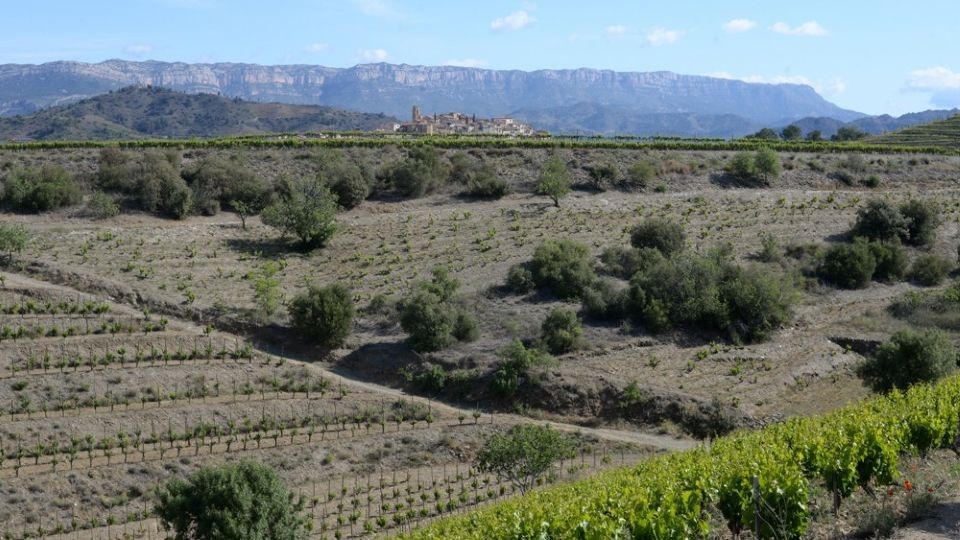
The village of Gratallops is surrounded by vineyards planted on black slate. The Monstant mountain range rises in the background.
The road bends sharply and a sign announces Ermita de Sant Pau - Mirador de la Batalla del Ebro (Sant Pau Hermitage - View of the Battle of Ebro). Barbier Jr. turns off the road and follows a dirt track into the forest. “Now you’re going to see L’Espectacle,” he tells me. I’ve rarely seen a vineyard with a more appropriate name—the terraces of L’Espectacle run down the dramatically steep hillside toward the northwest, home to old Garnatxa vines with tortuously twisted trunks. In spite of the lack of rain (this is a theme of the 2024 vintage, with fires breaking out in some of the vineyards near the end of the season), the vines stubbornly insist on budding, just like they do every year.
I’m beginning to get my bearings: both La Figuera and L’Espectacle are located in Montsant. A few minutes later, we’re back on the road and crossing the Siurana River into Priorat. The only noticeable change is the color of the hills. Where before, they were white with chalk, here, they’re gray and brown, and the vegetation is sparser.
Priorat is a tough, hardscrabble terroir where stone is the reigning theme—from being the chosen construction material for homes and terraces to hindering the planting of vines or almond groves. There are only 12 to 15 inches of Llicorella soil, strewn with chips of slate, above the extremely hard bedrock underneath. That rock is heavy slate, shattered by the heat and cold to form extremely tight channels. Vines take advantage of these channels to draw their sustenance, usually from spots where clay has settled and “the rainwater likes to hang out,” as Sara Pérez of Mas Martinet puts it. Pérez is another member of the generation that followed the revolutionaries of Priorat. A woman of character, she combines a sense of duty to keep moving Priorat forward with a more personal mission, which she began to set in motion at Mas Martinet in 2012. “I told myself, ‘When I get over my fears and shyness, I’ll change the style of my wines.’ In the end, I changed it while feeling both afraid and shy,” Pérez says, laughing. Her approach brings out a primary purity in her wines that, compared with the rich stylings of the past, makes them feel quite spare.
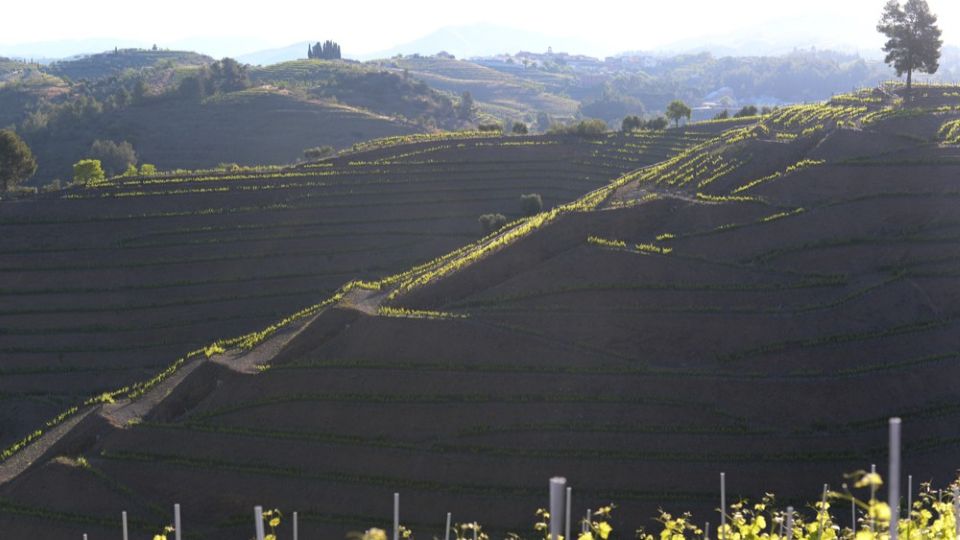
Belmunt del Priorat was a lead mine until the early 20th century. Today, the new "costers," or terraces, are laser-drawn and carved into the rock. Pictured are the vineyards of Casa Gran del Siurana.
From Friars to New Generations
The industry in Priorat began with Carthusian monks around 1194. This sunny, mineral-rich region, famous for its lead and tungsten mines, has been largely unsuitable for crops other than vines, peaches and almonds, with the exception of a few seams of calcareous clay on its periphery. Now home to about 100 wineries and 2000 hectares of vineyards, the resilience of the land is evident in both the wines and the people who make them.
After the Spanish Civil War in the late 1930s, Priorat fell under the shadow of the Franco dictatorship. Migration away from Priorat and to the cities was only to be expected, as the region was unable to sell its wines to anyone. By the end of the 1980s, this was a land ripe for rebirth, and that’s exactly what the Fantastic Five (as the pioneers of the renaissance are known) achieved. The 1990s saw a grand resurgence, giving rise to ripe, hefty wines with Bordeaux-style structures that put the region back on the map. The combination of the local terroir and the hot Mediterranean summer climate creates the ideal conditions for producing wines with 15-16% alcohol, deep concentration and large frames, which was precisely what consumers valued at the time. That style brought fame back to the region and helped it to flourish once again. Today, one kilogram of grapes from Priorat is worth three euros, where before, that fruit was essentially worthless.
It fell upon the second generation to refine this style, break with their forebears and set out on a substantially different path—Sara Pérez, René Barbier Jr. and Albert Costa, who runs Vall Llach, all tell this tale. Others, like Ester Nin of Nin Ortiz and Dominik Hubert at Terroir al Límit, took on the burden of defining an entirely new style for Priorat, drawing the ire of traditionalists as they crafted more ethereal interpretations.
Today, Priorat generally offers wines made in a more calibrated, refined and balanced style. These wines generally possess a distinctive quality, locally referred to as minerality: a talcum-powder-like texture that lingers on the finish of nearly every wine grown on the slate. This sensation shifts with the character of each variety. At one end, you have the light-footed wines, the Garnatxas colloquially known as “aerial,”although I prefer the term “ethereal.” On the other end, the Cariñenas, where some of that earlier stylistic substance remains. These are wines with precise acidity and textural suppleness. “Garnatxa is for parties, summer and exuberance,” says Jordi Jutglar, who runs the vineyards at Mas Doix. “Cariñena is the opposite: pure silk.” I couldn’t agree more. Where Garnatxa reflects an infusion of flowers and red fruit with some classical structure, Cariñena yields a more compact palate with delicious notes of pomegranate and a distinctly silky feel.
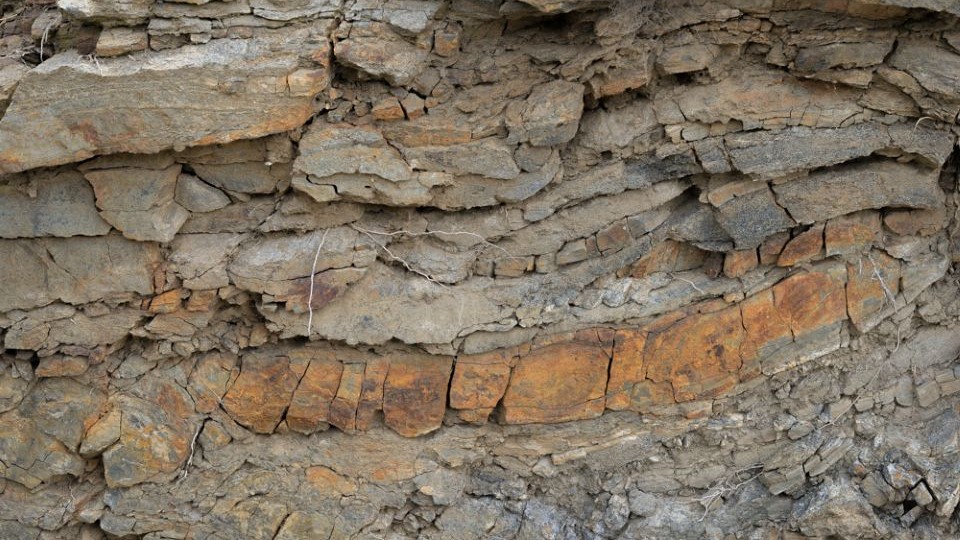
Priorat’s Llicorella
soils are made up of weathered slate. This photo shows fractured rock blocks,
where roots weave through and draw nutrients and water from the thin layer of
clay that gathers in the cracks.
Llicorella, the Concentrator
Priorat has one very unique characteristic: consistent soils. Whether it’s the black Llicorellas of Bellunt del Priorat or the browner ones of Poboleda, slate is a constant. Variations in sunlight, vine age and wind patterns inform the regional differences in the resulting wines, but the slate is always there. Of the nine towns in Priorat, Porrera and Poboleda are cooler due to the altitude and the wind, while Gratallops and Bellmunt are the warmest.
Just the thought of the dark rocks of Gratallops in the harsh August sunlight brings a bead of sweat to my brow. As I gaze upon some long-suffering Cariñena vines sprouting new shoots, olive green leaves rustling in the breeze just a few inches from the leaden slate, I realize the key to this terroir: it offers natural concentration with a pair of varieties that are resistant to the hot conditions because they maintain acidity—especially the Cariñena. This is why most of the lower-acidity Bordeaux varieties of the 1990s revolution are being regrafted, with only Syrah surviving from the Francophile era. René Barbier Jr. puts it best: “Priorat is about wines with character. If you want elegance, go to Burgundy.”
However, Montsant is quite different.
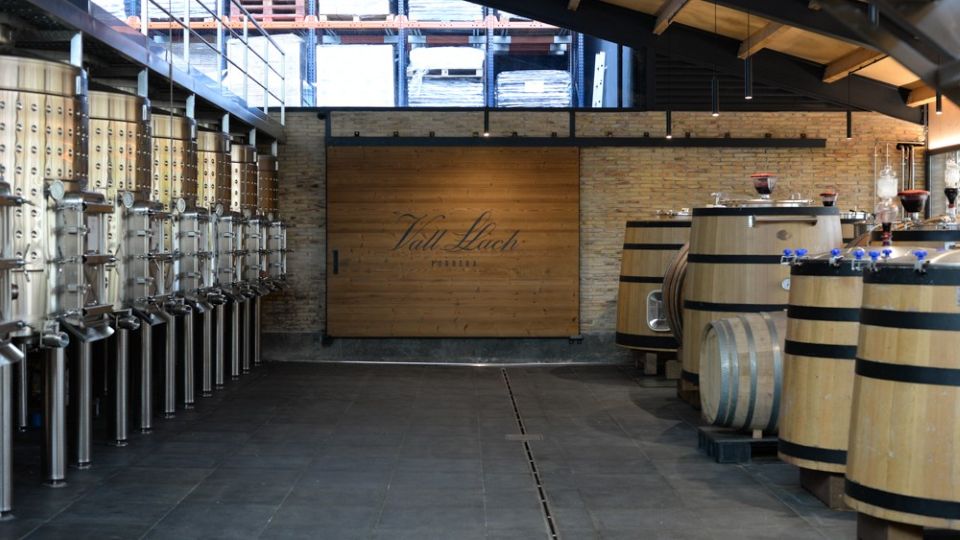
Vall Llach is
a modern winery operation that explores the nuances of Carignan. The number and
scale of the containers pictured here reflect their parcel-focused approach.
A Solid Ring
Established in 2001, the Montsant DO encompasses about 50 wineries and 1800 hectares under vine. On the map, you can see that Montsant covers a large area that wraps in a ring around Priorat, which is why it can be difficult to tell when you’re leaving one region and entering the other. Beyond the green sea I described earlier, the slate disappears from the surrounding sierras, replaced by limestone and red clay. Montsant takes its name from the sierra that dominates the skyline. Monks carved stairs into the mountains for the Scala Dei monastery (“God’s ladder”), which, despite being an icon of Priorat, actually lies outside the more famous region. In Montsant, the Llicorella gives way to ferrous and calcareous clays, so the wines are quite different. The similarly sunny climate makes for lighter, less concentrated, notably red-fruited wines, especially the Garnatxas.
I walked with brothers Miquel and Toni Coca i Fitó through a vineyard one Saturday morning when some miraculous raindrops were beginning to fall—the first of the dry spring and one of the final rainfalls of 2024. We muddied our shoes with a reddish, rusty sludge. The name of the nearby local village sums up the terroir: Masroig, or “Red House” in Catalan.
“The vines here are happier than in Priorat,” says Toni Coca i Fitó. The difference in terms of the lushness of the vines and the vegetation in general is quite notable. Looking toward Montalt, vivid green vines, forests and rural roads stretch as far as the eye can see. That afternoon, I visited Vinyes del Domènech, the rain now in full flow. There, the sludge was pale due to the chalk, and the Mediterranean forest was brought to life by the rain, the air filled with the scent of thyme, rosemary and mastic. Inspired by this landscape, Joan Ignaci Domènech has dedicated time and resources to researching the native flora in partnership with INCAVI, the Catalan Wine Institute. He explains, “We don’t associate biodiversity with the terroir, but we should. Humans ruin the terroir if we harm the native flora.”
In Montsant, nature plays a different role than it does in Priorat. The undergrowth here is lush, while on the barren slopes of Gratallops and Bellmunt, the Mediterranean herbs are much less prevalent. This is due in part to weeding in order to conserve water for the vines, but also because nutrients are at such a premium.
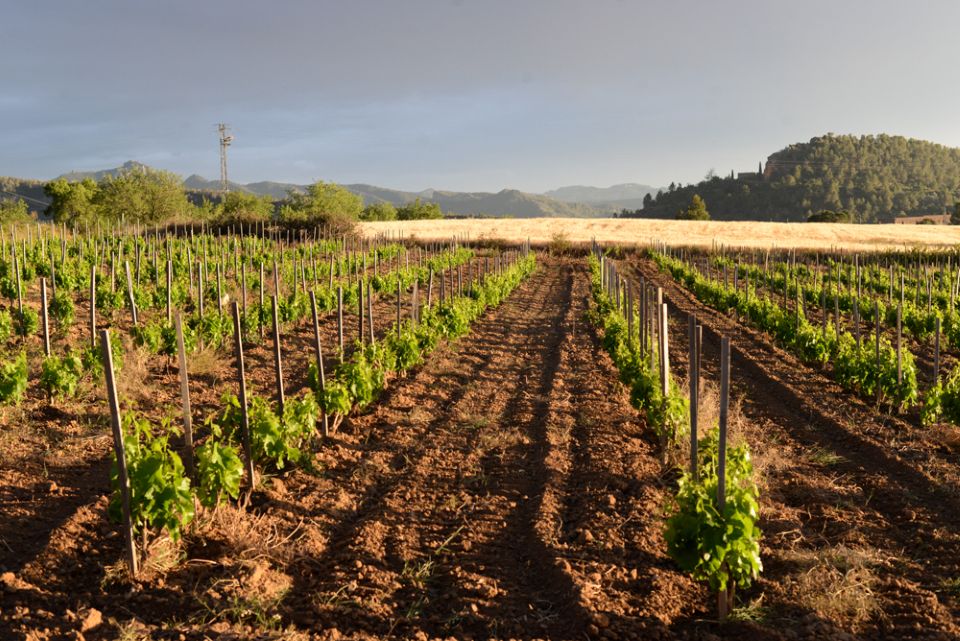
The clay soils on the outskirts of Falset in Montsant contrast with the slate soils of Priorat.
The final rays of the day’s sunlight filtered through the leaden clouds as I found myself in the winery belonging to Josep Grau in Capçanes. His story is quite typical of recent years. Attracted to the region by the fame of Priorat in the 1990s, the former financier started to make his own wines and eventually set up shop in Montsant (Priorat being too expensive). Today, he produces wines from both denominations in his own personal style, with elegance very much at the fore. Grau explains, “What interests me in Montsant is that we can make refined wines with drinker-friendly palates.”
The differences between Priorat and Montsant are quite striking. You’ll see for yourself in the 200 reviews in this report. I tasted most of these wines during my visit to Priorat and Montsant, and a handful in my office in Buenos Aires, Argentina.
© 2024, Vinous. No portion of this article may be copied, shared or re-distributed without prior consent from Vinous. Doing so is not only a violation of our copyright, but also threatens the survival of independent wine criticism.
You Might Also Enjoy
The Rambunctious Catalan Mediterranean and Beyond, Joaquín Hidalgo, September 2024
The Many Riojas of Rioja: A Tale of Forking Paths, Joaquín Hidalgo, April 2024
Reds From Toro: Old Vines and New Knowhow, Joaquín Hidalgo, December 2023
Ribera del Duero: A Shifting Frontier for Spanish Wine, Joaquín Hidalgo, November 2023
De la Revolución a la Evolución: Las Garnatxas y Cariñenas de Priorat & Montsant
JOAQUÍN HIDALGO | 7 NOVIEMBRE 2024
Conduce René Barbier (hijo) mientras subimos una serie de caracoles rumbo al pueblo de La Figuera en Montsant. La promesa es ver, desde un punto elevado, el Priorat. Es un tipo afable René, concentrado en lo que habla más que en el manejo, pero no se le escapan los detalles del camino. Lo conoce. Viene aquí desde que tiene memoria.
El camino es de una sola mano y trepa entre pinares. Las rocas calcáreas forman acantilados aquí y allá y mientras ascendemos pierdo la sensación espacial. Es algo que también conozco de memoria. Para quien se ha criado entre montañas, la sensación de que el horizonte está a la vuelta de una cornisa resulta siempre estimulante. Pienso en eso y siento la adrenalina de las alturas, el estímulo primario por ver qué hay del otro lado. Y lo que veo al llegar a la cima, luego de dejar atrás el pueblo y unas pocas terrazas de vid, me quita el aliento: un una suerte de mar, donde las olas son en verdad cadenas y cordones montañoso, percudidos por la erosión y contenidos a un lado por una muralla blanca –la sierra del Montsant– mientras que el resto de los bordes están formado por picos más altos. Es un mar verde esta primavera cuya blanda superficie en la distancia está aserrada, aquí, allá, por costers y terrazas, y salpicada cada tanto por los tejados de los nueve pueblos que enmarca el Priorat.

El pueblo de Gratallops está rodeado de viñedos plantados sobre las pizarras negras. En el fondo se recorta la Sierra del Monstant.
Con René vamos
conversando sobre la historia de la región. Su padre, René Barbier (Clos
Mogador), fue junto a Álvaro Palacios (L’Ermita), Josep Lluis Pérez (Mas
Martinet), Daphne Glorian (Clos i Terrases) y Carlos Pastrana (Clos de l’Obac),
quienes pusieron de nuevo al Priorat en el mapa del vino a comienzos de la
década de 1990, luego de un largo y despoblado letargo. Hasta entonces, la
región estaba considerada una de las más pobres de Catalunia, luego de la
filoxera y la Guerra Civil. Los viñedos sobrevivieron entre las laderas de
pizarras, tan duras como pobres, porque unos pobres viticultores se aferraron a
ellos y a su historia.
El camino hace un recodo profundo y un cartel anuncia Emita de Sant Pau - Mirador de la batalla del Ebro. René sale de la pista y se cuela por un camino de tierra que parte el bosque en este collado. “Ahora vamos a conocer L’Espectacle”, anuncia. Pocas veces he visitado un viñedo con un nombre tan pertinente: las terrazas descienden la ladera escarpada con orientación al noroeste, donde brotan unas Garnatxas de tortuosos troncos viejos. A pesar de la falta de lluvias (será un sino esta temporada 2024 que terminará incluso con incendios en algunos viñedos) la vid se obstina en brotar, como cada año.
Estoy algo confundido: tanto La Figuera como L’Espectacle pertenecen a Montsant. En cuestión de minutos, sin embargo, retrocedemos por la carretera y al cruzar el Río Siurana, volvemos al Priorat. Lo único que ha cambiado es el color de los cerros: si recién eran color tiza por el componente calcáreo, aquí son grises, pardos y más ralos en vegetación. Con el correr de los días entenderé bien las diferencias.
Priorat es un terroir duro, esforzado, donde hay que lidiar con la piedra para todo –desde la construcción de casas y terrazas, hasta para plantar una vid o un almendro–. Pero es la dureza de la piedra lo que le da el carácter a la zona. Solo unos 30, 40 centímetros de llicorella, un suelo astillado de pizarras, para luego llegar a la roca madre. Las pizarras son durísimas y pesadas, fracturadas por el calor y el frío, son surcadas por grietas muy apretadas. Allí se aferran las raíces de la vid, justo donde queda algo de arcilla “donde se entretiene el agua de lluvia”, como lo describe Sara Pérez. Ella también es segunda generación entre los revolucionarios de Priorat. Mujer de carácter, sintetiza el peso de llevar el Priorat adelante con una idea muy personal, desde que empezó a ocuparse de Mas Martinet en la añada 2012: “Cuando se me pase la vergüenza y el miedo, cambio el estilo, me dije. Al final cambié con miedo y vergüenza”, se ríe. Su estilo busca una pureza primaria en los vinos que, comparado con la riqueza del pasado, puede resultar algo desnudo.

Belmunt del Priorat, fue hasta entrado el silgo XX una mina de plomo. Los nuevos "costers" como le llamaba a las terrazas aquí hoy son dibujados a laser y esculpidos en la roca. En la foto, los viñedos de Casa Gran del Siurana.
Del Prior a las nuevas generaciones
Priorat inició sus días con los monjes cartujos hacia el año 1194. Esta región solar y mineral, famosa por sus minas de plomo y tungsteno, no era apta para muchos más cultivos que la vid, los duraznos y las almendras, con excepción de unas pocas vetas de suelos arcillo calcáreos en su periferia. Hoy cobija unas 2000 hectáreas de viñas en manos de unas 100 bodegas. Ese carácter resiliente se nota en los vinos y en las personas que hacen los vinos.
Pasada la Guerra Civil Española en la década de 1930, el Priorat entró en el cono de sombras del franquismo. La migración a las ciudades y al exilio se impuso en una zona cuyos vinos no compraría nadie. A fines de los años 80 era una tierra que pugnaba por su renacimiento. Eso fue lo que consiguieron los 5 Fantásticos, como se conoce a los pioneros de su renacimiento. Ahí está la épica de los 90, con vinos maduros y de estructura basada en variedades bordelesas o Garnatxas enjundiosas, que puso a la región en el mapa nuevamente. En esas condiciones de suelo y con el clima caliente del mediterráneo en verano, hacer vinos de 15, 16 grados de alcohol, concentrados y de estructura era sencillo. Y era, a la vez, algo que los consumidores premiaban en aquellos años. Ese estilo le devolvió la fama a la región y lograron hacerla floreciente. Un dato: hoy el kilo de uva llega a los tres euros, cuando entonces no se podía vivir de la viticultura.
A la segunda generación le tocó refinar esos estilos. Desdecir a los fundadores y emprender un camino sustancialmente diferente. De eso hablan Sara Pérez, René Barbier y Albert Costa, este último al frente de Vall Llac. Otros, como Ester Nin de Nin Ortiz o Dominik Hubert de Terroir al Limit, cargaron con pesos propios a la hora de definir un nuevo estilo para el Priorat, no falto de cuestionamientos entre los puristas, debido a su perfil etéreo.
Hoy Priorat propone un estilo más ajustado, de balance fino, y con paladares que ofrecen una rara condición que aquí se explica con justicia como mineralidad: una suerte de textura de talco que queda al final de cada vino nacido en las pizarras. Esa sensación tiene los matices propios de las variedades. En un extremo pueden estar los vinos alados, las Garnatxas que aquí llama aéreas y que prefiero nombrar como etéreas, mientras que entre las Cariñenas queda algo de aquel espíritu enjundioso, bien calibrados de acidez y con un punto de seda. “La garnatxa es fiestas, es verano y es exuberancia –define Jordi Jutglar al frente de los viñedos de Mas Doix–. La Cariñena es todo lo contrario: pura seda”.
No puedo estar más de acuerdo. Si la Garnatxa es una infusión de flores y frutas rojas, con algo de estructura clásica en ciertos estilos, la Cariñena es un catalizador de una paleta más apretada, con una deliciosa nota de granada y un paladar de compacta seda.

Los suelos de Llicorella están
formados por pizarras meteorizadas. En la foto se aprecian los bloques de roca
fracturada, donde las raíces se entreveran y obtienen los nutrientes y el agua
de la fina capa de arcilla que se acumula en las grietas.
Llicorella, el concentrador
Priorat tiene una magia: es una zona muy homogénea en materia de suelos. Sea en las llicorellas negras de Bellunt del Priorat o en las pardas de Poboleda, la pizarra es una constante que asume variaciones en la exposición solar del viñedo, en la edad de las plantas y en la circulación de los vientos. De los nueve pueblos del Priorat, Porrera y Poboleda son las zonas más frescas gracias a la altura y los vientos, Gratallops y Bellmunt se apuntan entre las más calientes. Carles Ortiz Nin-Ortiz lo pone en cifras: “Entre Gratallops y Porrera tenés hasta 5 grados de diferencia en verano”, subraya.
De solo pensar en las rocas oscuras de Gratallops al sol vertical de agosto una gota de sudor brota en mi mente. Observo cómo unas sufridas Cariñenas estiran sus sarmientos y unas hojas verde oliva vibran agitadas por la brisa a unos centímetros de las pizarras color plomo. Ahí está buena parte de la clave de este terroir, me doy cuenta: en que ofrece una concentración natural caldeada a fuego fuerte todo el verano, con dos variedades que son resistentes a esas condiciones, precisamente porque sostienen la acidez. En particular la Cariñena. Por eso hoy están reinjertadas casi todas las viñas bordelesas de la revolución noventosa, y sobrevive el Syrah como un testigo del período francés. Fue René quien lo dijo mejor que nadie: “Priorat es vinos con carácter. Para elegancia está Borgoña”.
Distinto es lo que sucede en Montsant.
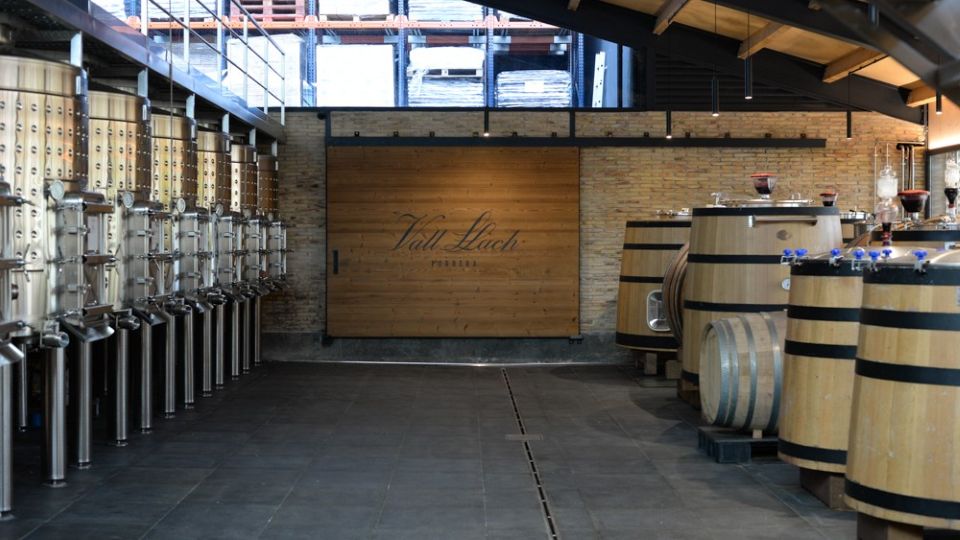
Vall Llach tiene una moderna bodega donde
explora las vertientes de la cariñena. La cantidad y escala de los recipientes
da una idea de la parcelación con la que trabajan.
El Anillo Sólido
Establecida en 2002, en la DO Montsant hoy operan unas 50 bodegas en unas 1800 hectáreas de vid. Basta mirar el mapa para darse cuenta que Montsant abraza al Priorat, lo rodea y cubre un área más extensa. Y es que fuera del mar verde que describí al comienzo, sobre las sierras aledañas y en los alrededores, desaparece la pizarra y surgen los suelos calizos y de arcillas rojas. Montsant tomó su nombre de la sierra que domina la vista,a la que los monjes cartujos subían con sus escaleras, dando nombre al monasterio de Scala Dei (escalera a Dios) y a la vez al ícono del Priorat, pero es una sierra que está fuera de la famosa región. Y si hablamos de una zona donde la llicorella cede el espacio a las arcillas ferrosas y calcáreas, la constitución de los vinos es radicalmente diferente. El mismo clima solar abre las puertas a vinos más ligeros, menos concentrados y donde la fruta roja domina las narices, sobre todo en Garnatxa.
Con los hermanos Miquel y Tony Coca i Fitó caminamos por la viña una mañana de sábado en la que caen unas milagrosas gotas –las primeras de esta primavera seca y una de las últimas de este 2024– y nos embarramos los zapatos de un fango rojo, color óxido. Desde donde estamos, en la cima de una loma, se ve el pueblo cercano. Su nombre es de lo más elocuente: Masroig. En catalán, casa roja.
“Las viñas aquí son más felices que en Priorat”, describe Tony. La diferencia entre la vegetación de las plantas, y de la vegetación en general, es notable. Hasta donde alcanza mi vista, hacia el Montalt, las viñas de un verde vivo se entremezclan con el bosque y los caminos rurales. Por la tarde llegaré hasta la base del cerro, cuando visite Vinyes del Domènech, con la lluvia ya declarada. Allí el fango será blanquecino por el calcáreo y el bosque mediterráneo tendrá el perfume de la lluvia. Basta caminar un poco para que el tomillo, el romero y el lentisco llenen el aire. No en vano Joan Ignaci Domènech investiga junto al INCAVI la flora nativa: “La biodiversidad no está asociada al terroir –se lamenta–. Pero debería estarlo. Los humanos nos cargamos el terroir si nos cargamos la flora nativa”.
En Montsant la naturaleza ocupa un lugar diferente al Priorat. Si aquí suma aromas y matices de garriga porque está vigente, en las laderas sufridas y peladas de Gratallops o Bellmunt las hierbas mediterráneas ralean. Un poco por las labranzas que implica mantener a raya a las hierbas para que no se beban el agua, otro poco porque los nutrientes son escasos.

Los suelos arcillosos a las afueras de Falset, ya en Montnsant, contrastan con los pizarrosos del Priorat.
Los últimos rayos del sol que se cuelan entre las nubes plomizas me encuentran en la bodega de Josep Grau en Capçanes. La suya bien podría ser la historia de los últimos años. Atraído a la región por el renombre de Priorat en los noventa, este ex financista se dedicó a hacer vinos hasta que logró montar su bodega en Montsant (ya que en Priorat no podía permitírselo). Hoy produce vinos en las dos denominaciones, con un estilo personal. Aquí la elegancia es parte de la ecuación. “Lo que me interesa de Montsant –define Grau– es que podemos hacer vinos de mayor finesa y paladares amables”.
La diferencia entre Montsant y Priorat es notable. De eso dan cuenta las más de 200 botellas de este reporte. Buena parte de ellas las probé en su lugar de origen. Un puñado, en cambio, fueron catadas en mi oficina de Buenos Aires, Argentina.
© 2024, Vinous. Ninguna parte de este artículo puede ser copiada, compartida o redistribuida sin el consentimiento previo de Vinous. Si se incurriese en ello, no solo se viola nuestro copyright, sino que también se amenaza la supervivencia de la crítica independiente de vinos.
También Podrías Disfrutar
El Agitado Mediterráneo Catalán y Más Allá, Joaquín Hidalgo, septiembre 2024
Las Muchas Riojas del Rioja: una Historia de Encrucijadas, Joaquín Hidalgo, abril 2024
Tintos de Toro: viñas añosas con sabia nueva, Joaquín Hidalgo, diciembre 2023
Ribera del Duero: una frontera en movimiento para los vinos de España, Joaquín Hidalgo, noviembre 2023
Show all the wines (sorted by score)
- Abadía de Poblet
- Acústic Celler
- Agrícola Falset-Marça
- Allvaro Palacios
- Buil & Giné
- Casa Gran del Siurana
- Celler de Capçanes
- Celler Mas Doix
- Cellers de Scala Dei
- Clos i Terrasses
- Clos Mogador
- Clos Salanca
- Coca i Fitó
- Companyia Viticola Sileo
- Coreografia
- Costers del Priorat
- Espectacle
- Estones Vins
- Familia Nin Ortiz
- Familia Torres
- Ferrer Bobet
- Historic
- Josep Grau Viticultore
- Lectores Vini
- Les Vinyes Forer Massard
- Marco Abella
- Mas Blanc Pinord
- Mas d’en Gil
- Mas Martinet Viticultors
- Olé Obrigado
- Rolland Galarreta
- Samsara Priorat
- Sarah i René
- Sindicat La Figuera
- Terroir al Límit
- Terroir Sense Fronteres
- Vall Llach
- Venus
- Venus Universal
- Vinyes d'en Gabriel
- Vinyes D'En Gabriel
- Vinyes Domènech
